
The Knights of Pythias is a fraternal organization and secret society founded in Washington, D.C., on February 19, 1864. The Knights of Pythias is the first fraternal organization to receive a charter under an act of the United States Congress.

A benefit society, fraternal benefit society, fraternal benefit order, friendly society, or mutual aid society is a society, an organization or a voluntary association formed to provide mutual aid, benefit, for instance insurance for relief from sundry difficulties. Such organizations may be formally organized with charters and established customs, or may arise ad hoc to meet unique needs of a particular time and place.
Prince Hall Freemasonry is a branch of North American Freemasonry created for African Americans founded by Prince Hall on September 29, 1784. Prince Hall Freemasonry is the oldest and largest predominantly African-American fraternity in the United States.
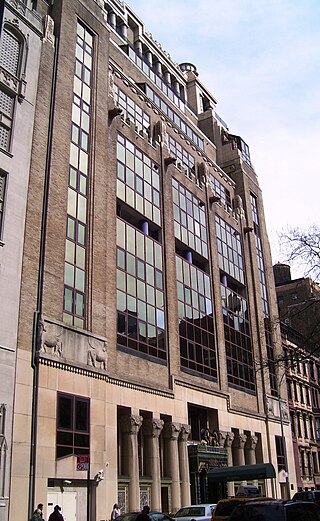
The Pythian Temple is a historic Knights of Pythias building at 135 West 70th Street between Columbus Avenue and Broadway in the Lincoln Square neighborhood of Manhattan, New York City. It was built in 1927 to serve as a meeting place for the 120 Pythian lodges of New York City, and later for many years housed a recording studio. Today it is an 88-unit luxury condominium building known as The Pythian.

The Knights of Pythias Temple in Louisville, Kentucky, also known as Chestnut Street Branch-Y.M.C.A., was built in 1914–15. It was designed by Henry Wolters. It is a buff-colored brick building with limestone trim.
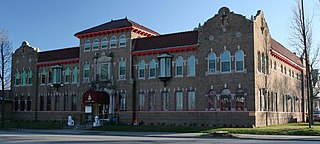
The Pythian Castle Lodge, also known as Crystal Palace, in Milwaukee, Wisconsin, United States, was built in 1927 by the Knights of Pythias, a fraternal organization. In 1988 it was listed on the National Register of Historic Places.
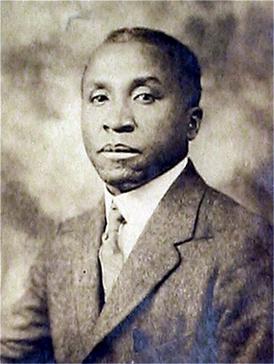
Walter Thomas Bailey was an American architect from Kewanee, Illinois. He was the first African American graduate with a bachelor of science degree in architectural engineering from the University of Illinois at Urbana-Champaign and the first licensed African-American architect in the state of Illinois. He worked at the Tuskegee Institute, and practiced in both Memphis and Chicago. Walter T. Bailey became the second African American that graduated from the University of Illinois.
The Philadelphia Pythians was one of the earliest Negro league baseball clubs, founded in 1865. African-American leaders Jacob C. White Jr. and Octavius V. Catto established the team. The Pythians were composed of primarily business and middle class professionals from the surrounding areas of Washington, D.C., Philadelphia, and New York City. Just two years after the Civil War ended, in 1867, the Pennsylvania State Convention of Baseball, located in Harrisburg, denied the "Pythian Base Ball Club" out of Philadelphia. The team dissolved after Catto's death in 1871 and a new team formed under the Pythian name in the National Colored Base Ball League in 1887. The new team's first season went 4–1. Due to financial troubles it folded after only one season.
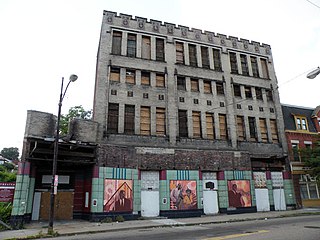
The New Granada Theater, which is located at 2007 Centre Avenue in the Hill District neighborhood of Pittsburgh, Pennsylvania, was built between 1927 and 1928.

The Knights of Pythias Temple is an historic Knights of Pythias building located at 2551 Elm Street in the Deep Ellum neighborhood of Dallas, Texas. Now operating as the Pittman Hotel, and previously also known as the Union Bankers Building, it was designed by African-American architect William Sidney Pittman and opened in 1916. Current renovations by Perkins + Will date to 2020.
The Pythian Sisters is a fraternal order with members throughout the United States and Canada. Although affiliated with the Knights of Pythias, they are not an auxiliary group as they have their own charter. The Pythian Sisters provided sick and death benefits to members.

Jacob C. White Jr. was an American educator, intellectual, and civil rights activist. Born to a successful and influential businessman, White received the finest education afforded to African-Americans of the time and became intertwined in the dealings of Philadelphia's most prominent black leaders. The first black man in the city to be appointed as a school principal at Roberts Vaux Consolidated School. During his tenure between 1864 and 1896, White reformed the institute and became the leading figure in the field of urban education in Philadelphia. Alongside his academic endeavors, White was significant in the sports field: he helped establish the Philadelphia Pythians, an early black baseball club. Following the shooting of his friend and fellow activist Octavius Catto in 1871, White became the top civil rights activist in the city, and remained active in the community until his death in 1902.

Samuel W. Starks was an African American community leader who achieved national prominence through his leadership in the fraternal order the Knights of Pythias of North America, South America, Europe, Asia, Africa and Australia. Starks was the first African American to serve as a state librarian when he was appointed as the West Virginia state librarian in 1901.
Thomas W. Stringer (1815–1893) was an American Christian minister in the A.M.E. Church, state senator in Mississippi, Prince Hall Mason, and the founder of the Knights of Pythias of North America, South America, Europe, Asia, Africa and Australia. He helped organize churches, schools, and fraternal organizations. He was elected to the Mississippi Senate in 1869 and served from 1870 until 1871.

Oscar William Adams Sr. was a journalist and publisher in the United States. He published the Birmingham Reporter. His son Oscar William Adams Jr. became an Alabama Supreme Court Justice.
The Order of Calanthe, originally titled the Independent Order of Calanthe, is a fraternal benefit society for African American women. It was established in Louisiana in 1883 as an auxiliary to the Knights of Pythias of North America, South America, Europe, Asia, Africa and Australia. Calanthe was the wife of Pythias in the Greek legend Damon and Pythias.
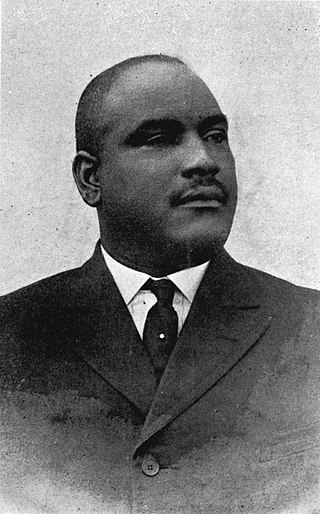
George Rubin (Reuben) Hutto was an American educator, prominent member of the Knights of Pythias, and a delegate to the first and third Pan-African Congresses.

Sumner Alexander Furniss (1874–1953) was a prominent Black doctor, founding member and president of the Indianapolis Young Men's Colored Association, councilman, and freemason.













